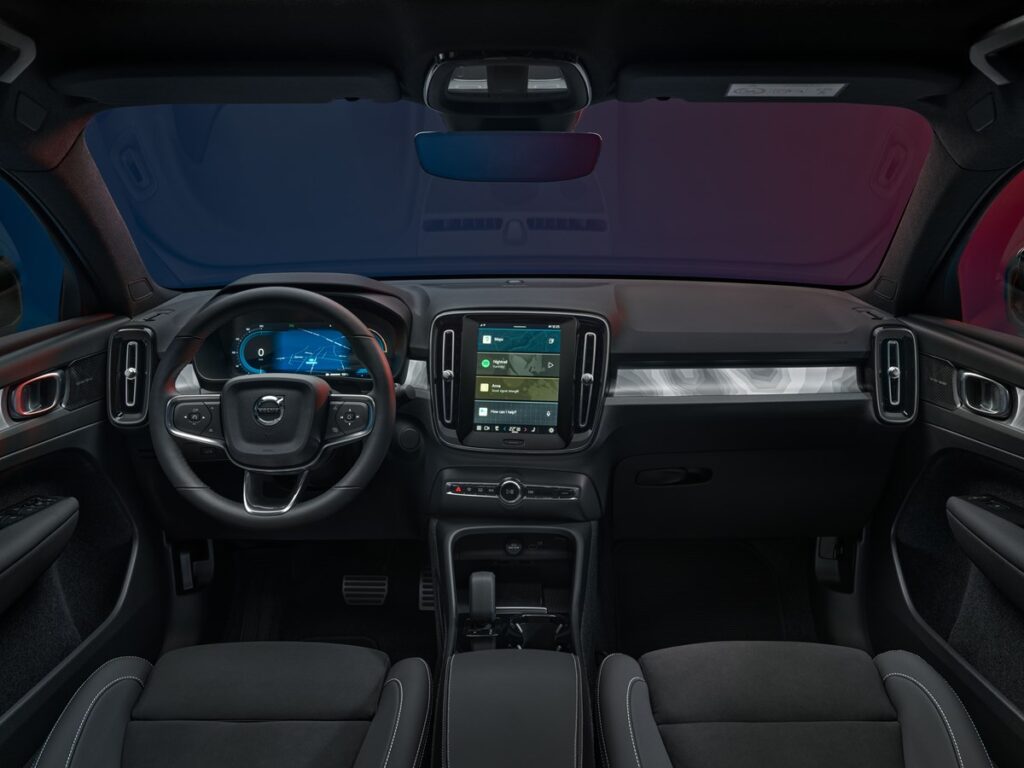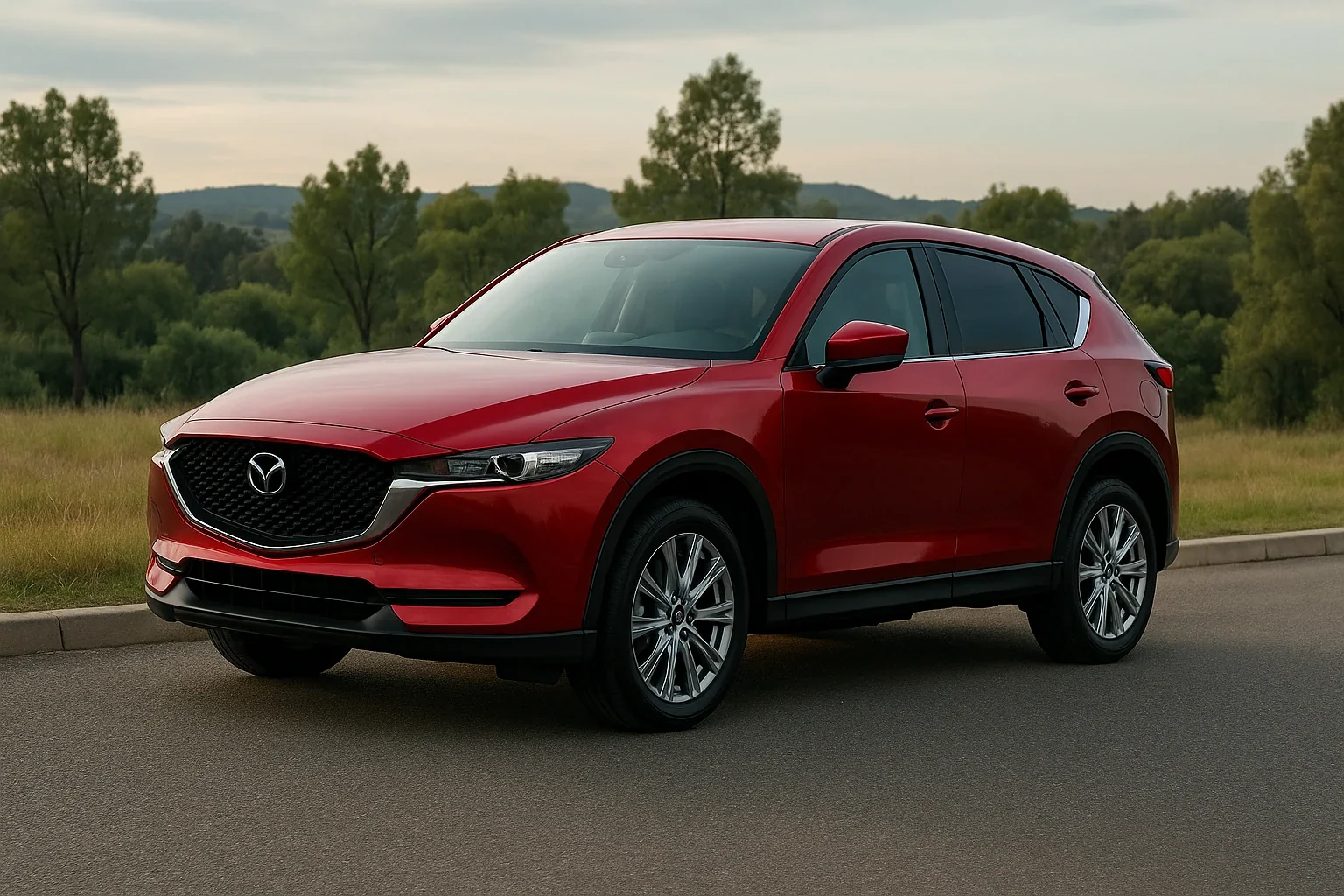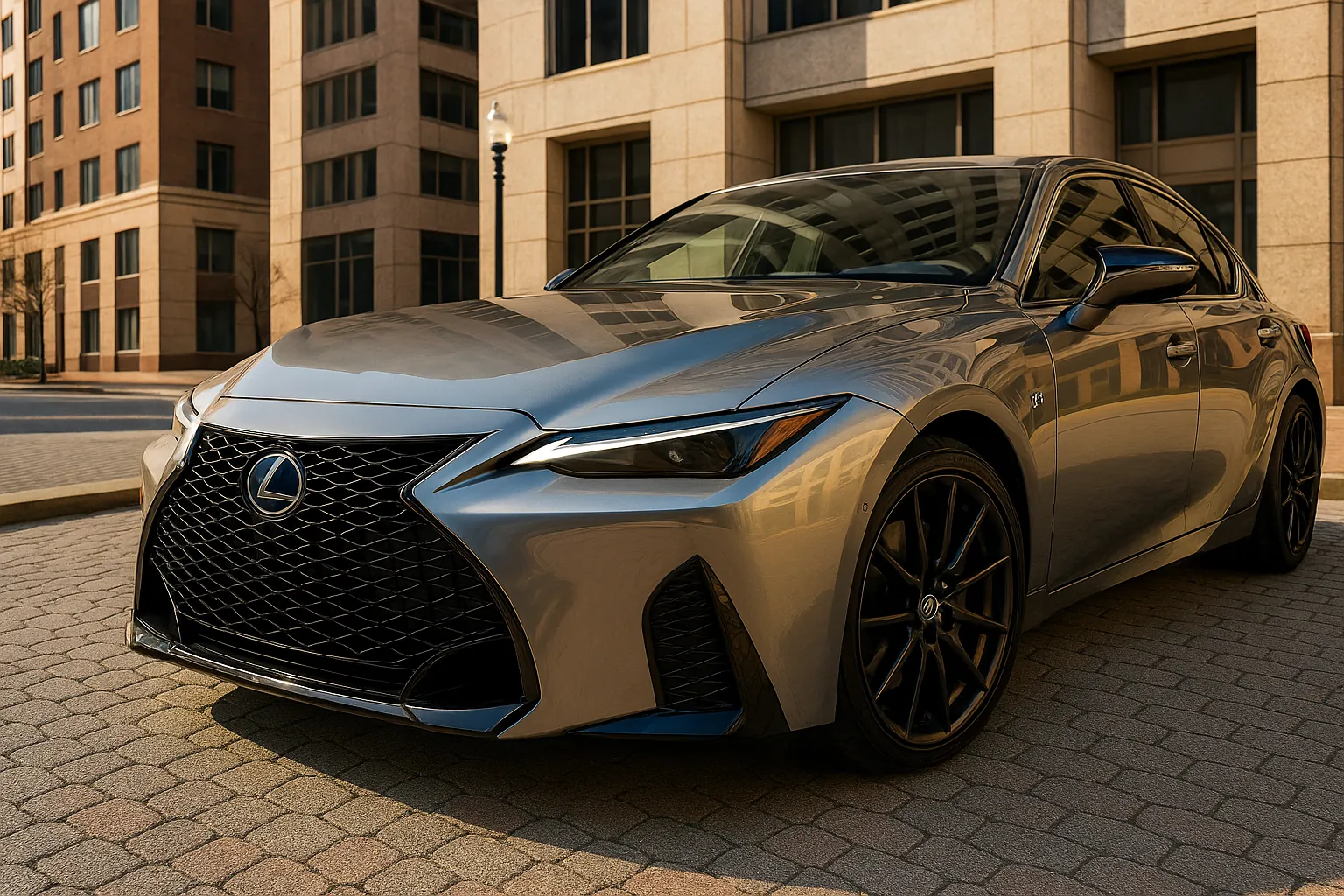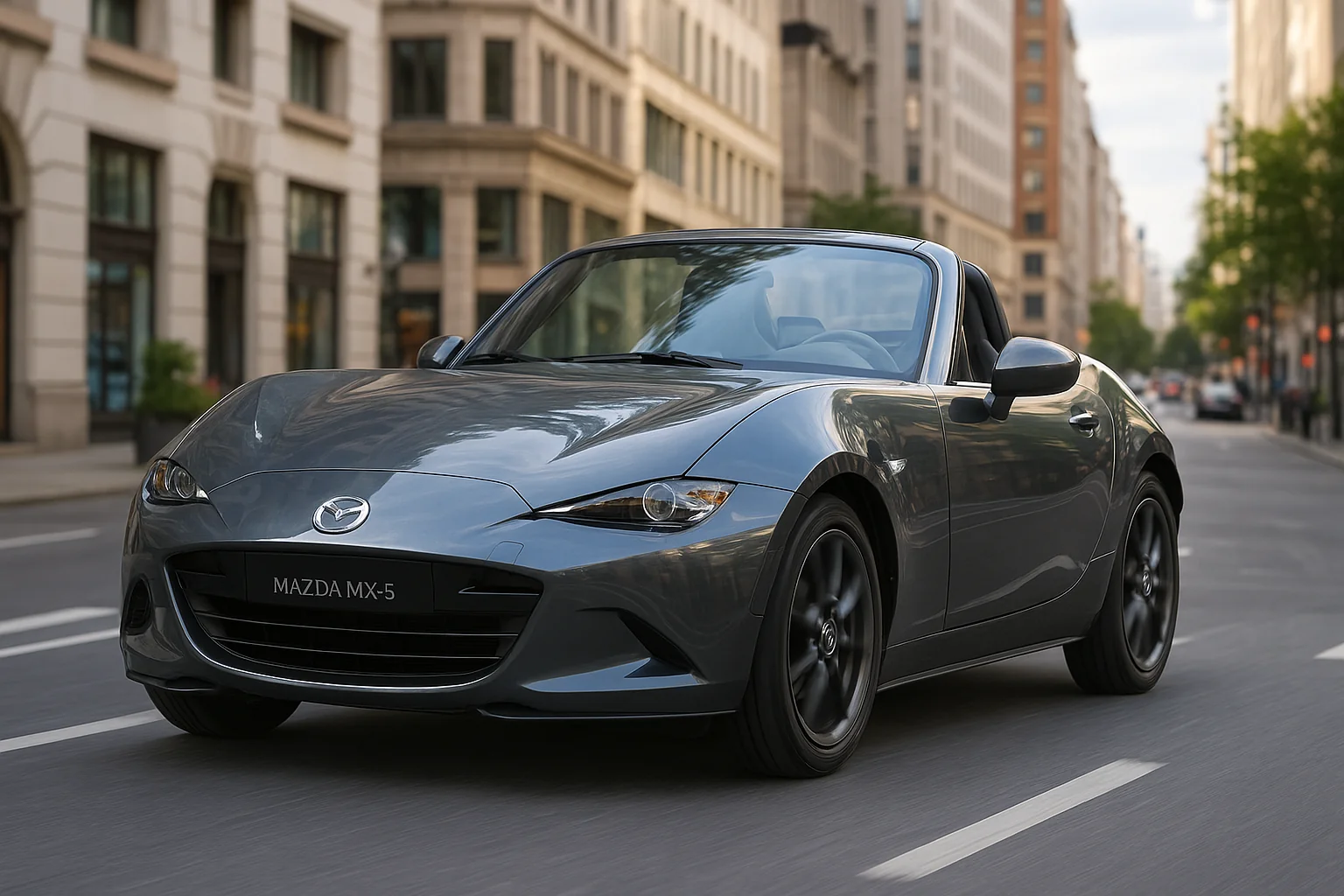
Price: $53,700–$61,800
8 /10
Rating
Pros
- Premium Scandinavian interior design
- Intuitive Google-based infotainment
- Powerful dual-motor acceleration
Cons
- Below-average EV range efficiency
- Slow DC fast-charging capability
- Compromised rear/cargo space
Overview:
The XC40 Recharge is a premium electric crossover that nails the basics but stumbles over EV expectations. The dual-motor setup delivers 402 hp and neck-snap acceleration, though its 223-mile range trails the Hyundai Ioniq 6 and Tesla Model Y. Charging? A slow 150 kW max means more coffee breaks on road trips. At least the Google-based infotainment is refreshingly logical—no PhD required to pair your phone.
Build quality here is textbook Volvo: tailored upholstery, thoughtful storage cubbies, and a classy minimalist design that shames the Audi Q4 e-tron’s plasticky cabin. But the raked roofline sacrifices rear headroom, and the cargo space feels smaller than the gasoline-powered XC40. Want to haul gear? Hope you’re into Tetris. The standard AWD and revised suspension handle confidently, but understeer still creeps in during aggressive turns—enthusiastic drivers might yawn.
Volvo’s semi-autonomous pilot assist works smoothly… until it phantom-brakes for highway shadows. The upscale vibe and safety tech (hello, pixel headlights) appeal, but the slow charging speeds and lackluster range make it a tough sell against the Genesis GV70 Electrified. At least the revised bumpers and premium materials justify part of the price tag. For something more balanced between utility and comfort, the Volvo V60 Cross Country continues to stand out with its rugged practicality and refined ride.
Who’s it for? Buyers prioritizing Scandinavian design over cutting-edge EV specs. It’s stylish, practical enough, and quieter than a Jaguar I-Pace, but the compromises (range, charging) keep it from leading the luxury-EV pack. A solid alternative—if you’re not obsessed with numbers.
What's New?
Volvo’s updates this year feel like a Swedish minimalist’s take on progress—subtle, practical, borderline underwhelming. The redesigned bumpers and pixel headlights offer a sharper aesthetic, though they’re about as groundbreaking as Volvo’s signature gray upholstery. Inside, the Google-based interface finally boots up reliably (praise Loki), and the semi-autonomous driving mode now navigates highway curves without the existential dread of earlier versions.
New regenerative braking modes add actual usability in traffic, but the stubborn 223-mile range lag behind the Hyundai Ioniq 6’s 800V hustle. The dual-motor setup’s 402 hp still delivers Nordic fury off the line, though the 78-kWh battery tech feels as fresh as a five-year-old iPhone. At least the cabin’s premium vinyl and storage tweaks elevate it from “airport rental” to “Stockholm loft.” Shame the competition treats efficiency as a priority, not an afterthought.
2022 vs. 2023 Volvo XC40 Recharge: What's the Difference?
Volvo’s 2023 XC40 Recharge isn’t an all-new model—it’s the 2022 with a facelift and a caffeine boost. The refreshed front end looks sharp, but minor changes like renamed trim levels (Core? Plus? Ultimate? Groundbreaking) won’t distract from the fact that the 15-mile increase in driving range still can’t outrun range anxiety. Inside, the leather-free upholstery feels eco-friendly yet somehow cheaper than your cousin’s IKEA couch, but hey, at least the standard wireless device charging pad won’t fry your phone—it just charges slower than a dial-up modem. Want savings? Skip the 2022 XC40 Recharge reviews—they’re as lukewarm as last year’s coffee—and hunt discounts on the older model instead. Or gamble on Best New Car Lease Deals for the 2023, knowing Volvo’s decision to tweak, not transform, means new vehicles like this still trail Tesla’s tech by a Swedish mile.
Pricing, Trim Levels, and Best Choice
Volvo wants $54,600 for the 2023 XC40 Recharge Twin Plus, and if you’re feeling fancy, the loaded Twin Ultimate leaps to $60,800—roughly the cost of a small yacht, minus the ocean views. The cabin’s luxurious materials and Harman/Kardon stereo system almost distract you from the EV’s real-world 223-mile range, which trails the Tesla Model Y and Ford Mustang Mach-E like a kid dragging heels to school. Sure, the 20-inch wheels look sharp, and the semi-autonomous driving mode works… when it feels like it. But adaptive cruise control shouldn’t require a mid-range trim to feel brilliant.
Skip the EX40 theatrics. The Twin Plus nails solidly attractive basics: spacious seating, automatic everything, and headlamps that won’t embarrass you at night. Is it worth it? Only if you’re allergic to the competition’s better math. Volvo built this model to charm your inner minimalist—just don’t mention the price-to-trim ratio. Or the options that nickel-and-dime you into existential crisis.
Which Is the Best 2023 Volvo XC40 Recharge Model to Buy?
Stick with the Core trim—unless you enjoy lighting money on fire for “premium” badges. The electric powertrain and all-wheel drive are standard, and Volvo’s Google-based infotainment system (hello, built-in Google Maps) works… when the 9-inch touch-screen isn’t lagging like a 2008 laptop. Apple CarPlay and Android Auto? Present, but buried under menus deeper than your unresolved text threads. Blind-spot monitoring is included, which is good because the range (223-293 miles) won’t save you from merging semi-trucks. Buyers eyeing pricier models: The base already has most standard features, and the voice recognition still mishears “play Nickelback” as “call 911.” Save the cash for car washes—this thing’s a dirt magnet.
The Real Cost of Swedish EV Luxury (and How Your Wallet Feels It)
Owning the XC40 Recharge is like a high-maintenance relationship with a Swedish art curator—stylish, but your wallet will feel the Stockholm winter sting. EV depreciation hits hard here: Kelley Blue Book projects a 35% value drop after three years, worse than the Tesla Model Y’s 28% slide. Luxury electric SUV insurance rates? Brace for $2,200/year (20% pricier than gas Volvos), thanks to battery repair nightmares and Volvo’s OEM-only parts policy. At least the EV maintenance costs are low—no oil changes, just tire rotations—but real-world electric vehicle efficiency is a letdown: Car and Driver saw 190 miles in cold weather, forcing pit stops faster than an IKEA shopping spree. Volvo’s 8-year battery warranty cushions the blow, but rivals like the Hyundai Ioniq 5 dangle free charging credits to ease range anxiety. Bottom line? This boxy Swede charms with design, but Volvo XC40 Recharge long-term costs demand a trust fund or selective amnesia.
Powertrain & Performance
Let’s start with the EV powertrain: Volvo’s dual-motor setup pumps out 402 horsepower and 486 pound-feet of torque, delivering instant thrust that slingshots this box to 60 MPH in 4.3 seconds. It’s quick, but not “sell-your-soul-to-the-devil” fast—though launch control turns stoplights into personal test tracks. The throttle is almost too responsive; breathe on it and you’re at illegal velocities before the stereo finishes a ABBA chorus.
That AWD grip? Flawless. Traction control smothers wheelspin, even when you floor it mid-corner. But handling feels like steering a well-dressed fridge—competent, but you’ll never confuse it with a sports SUV. The compliant ride soaks up potholes, though, and refined cruising makes highway drives eerily serene. Off-road mode adds ground clearance, but let’s not pretend this is a Land Rover.
One-pedal driving is brilliant in traffic, though the regenerative braking’s aggressiveness might leave passengers carsick. The 78-kWh battery delivers decent range, but hammer the throttle and it drains faster than your phone on TikTok. Merging maneuvers and high-speed passing? Effortless. Just don’t expect driving dynamics to match the EV’s performance chops—this is a commuter weapon, not a track toy.
Range & Charging
Let’s get this out of the way: the 2023 Volvo XC40 Recharge’s 78-kWh battery pack delivers an EPA-estimated 223 miles on a full charge. That’s fine if you’re competing against the Audi e-tron’s nap-inducing figures, but it’s a disadvantage next to the Model Y’s 300-mile hustle. Volvo’s updated EPA numbers beat the 2021 model’s 208-mile range, but real-world testing at 70 MPH drops efficiency to 2.6 mi/kWh—good luck stretching this to a theoretical 203. Math isn’t kind to the XC40.
Floor the throttle and efficiency plummets to 2.2 mi/kWh (observed 190 miles in winter), but ease off and summer highway drives in mild weather nudge it to a slightly less depressing 2.8 mi/kWh. That’s still 25% worse than a Model Y—enough to make your charging stops feel like a part-time job.
Charging? The 150-kW DC fast-charging terminals can juice from zero to 80% in 40 minutes… if you find a speedy fast charger. At home, the 11-kW onboard charger takes eight hours on a 240-volt outlet—slow, but tolerable if you’re paying cheap rates (and your employer conveniently foots the bill). Everyday usability? It’s capable, but road trips get trickier when electrical usage spikes with freeway driving or timid acceleration to maximize range.
Efficient this isn’t. The XC40’s frugality appeal crumbles when you realize the digital display’s 125-mile estimates after ¾ charge are pure fantasy. Volvo polished the standard equipment, but grand scheme, the price gap between this and rivals buys a lot of electricity. At least the power source outputs are installed for your lifestyle—assuming your lifestyle involves hugging Level 2 chargers.
Interior and Comfort
Let’s start with the good: the interior’s luxurious blend of leather, suede, fabric seats, and wool fibers feels like a Scandinavian spa, minus the overpriced cucumber water. The front seats are comfortable, but the forward angle seating position has tall drivers hunched like Gollum eyeing the One Ring—limited steering wheel adjustability doesn’t help. Legroom? Fine if you’re built for longer torsos, but dimensionally, this compact SUV’s small doors and back seats that barely fit 6 feet humans make it feel like a yoga retreat for contortionists. At least the panoramic glass roof and large windows offer good visibility, and the optional 360-degree camera saves your rims when maneuvering in tight spaces.
Storage cubbies and power outlets are everywhere, and the dash’s cool material with a topographic map texture that glows at night is interestingly neat—a creative alternative to traditional wood trim inserts. But the in-car operating system runs on Google functionality that’s intuitive until the controls freeze during a slow-booting delay mid-climate control tweak. Yes, it’s quieter than a mime convention, but good luck syncing Spotify without yelling louder than the onboard systems’ delays. User interface? More like user in-your-face.

Cargo & Practicality
Let’s be real: the XC40 Recharge’s 20.4-cubic-foot trunk is fine for kid duty or a Costco run, but don’t expect 3,500 pounds of towing heroics—this EV’s rated for a modest 2,000 lbs, enough for a pop-up camper but not your friend’s boat. The 60/40-split folding rear seats help with bulky rear-facing seat juggling, but the smaller cargo area compared to the Model Y or Mach-E means you’ll Tetris your items like a pro. At least the felt-lined doors and foldable tray add useful space for your grocery holder or removable trash bin, which is interestingly neat until you realize the 1.5-cubic-foot frunk fits a handbag, not a week’s groceries.
Storage spaces? The cabin’s clever, but access to the pass-through feels like solving a Rubik’s Cube. Flip-up doors and child seat anchors make kid duty manageable, though a tight fit with a Polestar 2-sized stroller will test your patience. And while rivals brag about 2,000 pounds of muscle, Volvo’s competition here is… a rattling sense of resignation. Sure, it’s practical—just don’t pretend it’s an SUV champ.
Tech & Connectivity
Praise the tech gods: the XC40 Recharge’s Google-based Android Automotive OS is mostly intuitive, with Google Maps baked into the digital gauge cluster so you won’t miss your exit mid-driving rant. The wireless smartphone charging pad (sadly optional) and USB-C ports keep your Apple iPhone charged, but good luck controlling the small on-screen buttons while dodging traffic—I learned this the hard way. Bluetooth connection? Stable, unless you’re juggling connectivity options like a clown. At least the voice recognition system (thanks, Google Assistant) actually works, unlike Volvo’s old Sensus Connect nonsense.
The Google OS is intuitive, but the Polestar 2’s identical system feels snappier—like swapping a Volvo sedan for a Lotus, minus the speeding tickets. Connectivity options include Android Auto-level functionality without the app itself—because Volvo’s collaboration with Google means you’re stuck with pricey apps from the Play Store. The 12-volt outlets and wireless Apple CarPlay are nice, but the infotainment system’s software still feels like a beta version next to the Polestar 2’s full suite. And those advanced driver aids? They actuate like a nervous intern, but hey, at least the data connection for software updates doesn’t drop. Mostly.
Safety
Volvo’s XC40 Recharge throws safety at you like confetti at a parade: IIHS Top Safety Pick+, NHTSA 5-star Rating, and Pilot Assist that semi-competently guides you in city traffic. The lane-keeping assist aggressively fights drifting, but it feels like a backseat driver yelling “STAY IN YOUR LANE, KAREN.” Automatic emergency braking detects pedestrians, cyclists, and wayward animals—unless it’s a plastic bag, which it also detects, slamming the brakes like you’ve hit a deer. The Park Pilot system alerts you to vehicles lurking in parking lots, but good luck trusting it to guide you into a tight spot without sweating.
Key features:
✅ Overzealous lane-keeping feels like a nagging co-pilot.
✅ Auto-braking works—unless it mistakes trash for threats.
✅ Parking aids exist but demand human supervision.
Warranty and Maintenance Plan
Volvo’s well-rounded warranty package for new cars includes a complimentary scheduled maintenance plan for three years or 36,000 miles, plus a limited warranty stretching 4 years/50,000 miles. The powertrain warranty and battery components are covered for 8 years/100,000 miles—standard for EVs, but hey, at least it aligns with ownership paranoia. Roadside assistance lasts four years, but competitors like Hyundai offer longer coverage. Enjoy scheduled services every 10K miles, but don’t expect freebies beyond the basic powertrain warranties.
Key features:
✅ Three years of free scheduled maintenance.
✅ Battery coverage outlasts most competitors’ basic plans.
✅ Roadside assistance lasts four years—adequate, not exceptional.
2023 Volvo XC40 Recharge models
Volvo offers three trim levels—Core, Plus, and Ultimate—all sharing the same 78-kWh battery pack and all-wheel drive via electric motors on each axle. The output? A generous 402 horsepower and 486 lb-ft of torque, which sounds impressive until you realize the Ultimate trim’s feature highlights are just a nicer cabin and fluff, not more power. The XC40 Recharge’s standard specs are identical across the floor, so paying extra for Plus or Ultimate feels like buying a fancier water bottle for the same tap water.
2023 Volvo XC40 Recharge vs. the Competition
Volvo XC40 Recharge vs. Volvo C40 Recharge
Choosing between the XC40 Recharge and its C40 sibling? Congrats, you’re picking between twins who swear they’re not identical. Both share the same corporate electric powertrain (4.7-second sprint to 60 mph, yawn) and Volvo’s interior that’s as cozy as a Stockholm Airbnb. But the XC40 wins on space—its boxy style hides actual cargo room, while the C40’s sleek roofline murders rear-seat headroom. Driving range? Same mediocre 223-293 miles. Save your dollars and buy the XC40 quickly; the C40 costs more for less practicality and a haircut you’ll regret by 2024.
Volvo XC40 Recharge vs. Tesla Model Y
Want an EV crossover that doesn’t feel like a science project? The XC40 Recharge’s interior nails quality—actual buttons, real materials, none of Tesla’s complicated iPad-on-wheels vibe. But Volvo’s infotainment system still drives you mad with menus deeper than Elon’s Twitter DMs. The Model Y stomps it on EV capability: longer ranges (330+ miles), faster charging, and Tesla’s laughably superior tech. Sure, the Recharge build feels solid enough to survive a Viking raid, but its small cargo space and glacial driving range make it a concern for road trips. Money talk? The Model Y costs less, offers more configurations, and actually earns the sports crossover badge. Appointments vs. electric IQ—pick your poison.
| Trim Level | Features |
|---|---|
| Core |
|
| Plus |
|
| Ultimate |
|
Gallery:
Images sourced from volvo Newsroom.






This Post Has 2 Comments
Pingback: 2023 Lexus RZ 450e Review: Luxury EV Tested
Pingback: 2025 Volvo V60 Cross Country Review: Wagon With Style